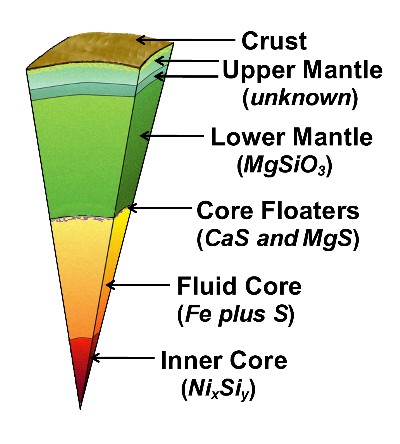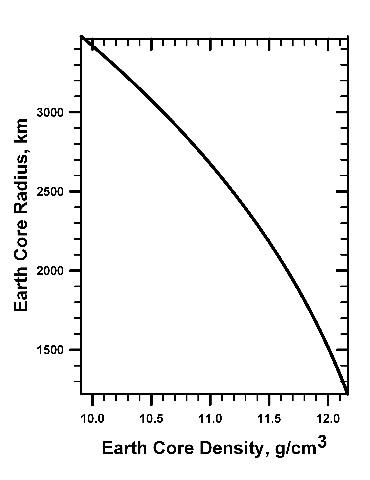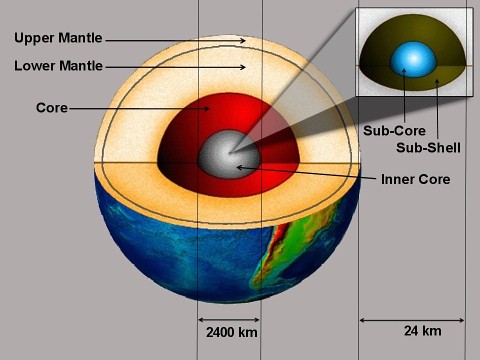 
J. Marvin Herndon's Physical Impossibility of Earth-Core Convection |
|
|
Heat a pot of water on the stovetop. Before it starts to boil, the water begins to circulate from bottom to top and from top to bottom. This is called convection and it can be better observed by adding a few tea leaves, coffee grounds, celery seeds, or the like, which are carried along by the circulation of water. Convection occurs because heat at the bottom causes the water to expand a bit, becoming lighter, less dense, than the cooler water at the top. The warmer, less dense, water rises to the top as the cooler, denser, water descends. This all seems so simple that it is no wonder that the convection process has been widely (but falsely) assumed to occur deep within the Earth’s core.  About 95% of the mass of the Earth consists of just two parts; the fluid, iron-alloy core and the solid, silicate-rock mantle, as illustrated at right. In 1939, Walter Elsasser postulated Earth-core convection to make tenable his idea that the Earth’s magnetic field is generated by convection-driven dynamo action within the Earth’s fluid core [1]. At the time, and until recently, there was no reason to suppose that any fluid, electrically conducting region, except the main core, exists within the Earth [2, 3]. Note that Earth-core convection was not independently observed, but rather, was assumed to exist so as to satisfy the underlying conditions for a different theory.
In 1900, Bénard observed the formation of a pattern of cells [convection cells] developing in a thin layer of water heated from beneath [5]. In 1916, Lord Rayleigh [6] derived a dimensionless number – now called the Rayleigh Number – to quantify the onset of instability, which would lead to convection in a thin, horizontal layer of fluid heated from beneath. For decades, calculation of a high Rayleigh Number has been taken to justify the existence of Earth-core convection. The advice for students, generally speaking, as stated in Herndon's book, Maverick’s Earth and Universe [7] is to “Look deeper and look questioningly.” And, certainly, that is the case here.
It is instructive to consider and to discuss some of the reasons why convection, as commonly observed on the stovetop and as described above by Nobel Laureate Chandrasekhar, is impossible within the Earth’s core. On the stovetop, convection occurs because heat at the bottom causes the water to expand a bit [much less than 1%], becoming lighter, less dense, than the cooler water at the top. This is a potentially unstable, top-heavy arrangement which the fluid attempts to redress by convection. So, in what ways is that different from the Earth’s core and how do those differences impact the convection process? The Earth’s core differs from the stovetop example in two important ways. First, as shown in the figure at right, because of the over-burden weight, the Earth’s core is about 23% more dense at the bottom than at the top [8], as illustrated at right. The tiny, tiny amount of thermal expansion at the bottom cannot make the Earth’s core top-heavy and cannot cause a thermally-expanded “parcel” from the bottom to float to the top of the core as required for convection. Thus, the Earth’s core cannot engage in convection. Second, because the Earth’s core is wrapped in a thermally insulating blanket, the silicate-rock mantle, heat cannot be efficiently removed from the top of the core. So, maintaining an “adverse temperature gradient” [i.e., the top of the core being cooler than the bottom] for extended periods of time, a condition necessary for convection, is impossible [3].
For Teachers: Teaching Students to Question Earth-Core Convection (click here for pdf) YouTube Demonstration: Origin of Earth's Magnetic Field (click here) |
| References | |
| 1. |
Elsasser, W.M., On the origin of the Earth's magnetic field. Physical Review, 1939. 55, 489-498. |
| 2. | Herndon, J. M., Sub-structure of the inner core of the Earth. Proceedings of the National Academy of Sciences USA, 1996, 93, 646-648. (click here for pdf) |
| 3. | Herndon, J. M., Nuclear georeactor generation of the Earth's geomagnetic field. Current Science, 2007, 93, 1485-1487. (click here for pdf) |
| 4. | Chandrasekhar, S., Thermal Convection. Proceedings of the American Academy of Arts and Science, 1957. 86(4), 323-339. |
| 5. | Bénard, H., Les Tourbillions cellulaires dans une nappe liquide. Renue generale des Sciences pures et appliquees, 1900, 11, 1261-1271 and 1309-1328. |
| 6. | Lord_Rayleigh, On convection currents in a horizontal layer of fluid where the higher temperature is on the under side. Philosophical Magazine, 1916. 32, 529-546. |
| 7. |
Herndon, J. M., Maverick's Earth and Universe. 2008, Vancouver: Trafford Publishing. ISBN 978-1-4251-4132-5. |
| 8. | Dziewonski, A.M. and Anderson, D. A., Preliminary reference Earth model. Physics of the Earth and Planetary Interiors, 1981. 25, 297-356. |
| 9. | Herndon, J. M., Nature of planetary matter and magnetic field generation in the Solar System. Current Science, 2009, 96, 1033-1039. (click here for pdf) |
| 10. | Herndon, J. M., Uniqueness of Herndon's georeactor: Energy source and production mechanism for Earth's magnetic field. 2009, arXiv:0901.4509 (click here for pdf) |
| 11. | Herndon, J. M., Geodynamic basis of heat transport in the Earth. Current Science, 2011, 101, 1440-1450. (click here for pdf) |



